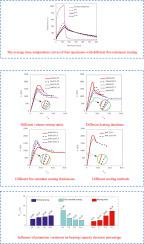Journal of Constructional Steel Research ( IF 4.0 ) Pub Date : 2021-09-02 , DOI: 10.1016/j.jcsr.2021.106934 Xia Yang 1 , Zhigang Li 2 , Yu Chen 3 , Hao Yang 1

|
This paper reports an experimental study on the mechanical performance of concrete encased steel (CES) stub columns after exposure to high temperatures. A total of 81 CES stub columns are tested, including 77 specimens that are heated for different durations and 4 that are unheated. Each test examines the influences of volume-stirrup ratio, heating duration, fire resistant coating thickness and cooling method (air-cooled and water-quenched) on the strength, deformation, elastic modulus and ductility characteristics of specimens. Findings show that heating duration and fire-resistant coating thickness have the greatest effects on the mechanical response of CES stub columns. The effects of volume-stirrup ratio and cooling method decrease in turn. The residual strengths of post-fire CES stub columns are positively related to volume-stirrup ratio and fire-resistant coating thickness and negatively correlated with heating duration. Without fire protection layer, CES stub columns on average retained 0.89, 0.76, 0.58 and 0.5 times of the original strength after exposure to high temperature with heating durations of 0.5 h, 1 h, 1.5 h and 2 h. After being protected by fire-resistance coating of 16 mm thick, the strengths on average only decrease by 5.45%, 5.96%, 13.81% and 20.38%, respectively. Water cooling on average decreases the resistance to compression by 5.6% compared with natural cooling. Finally, formulae are suggested for predicting the ultimate strength of CES stub columns after exposure to high temperature. It is verified that the calculated values from the formulae are in good agreement with the experimental results.
中文翻译:

暴露于高温后的混凝土包裹钢短柱的性能
本文报告了混凝土包钢 (CES) 短柱在暴露于高温后的力学性能的实验研究。总共测试了 81 个 CES 短柱,其中包括 77 个加热不同持续时间的样品和 4 个未加热的样品。每项试验均考察了体积-搅拌比、加热时间、耐火涂层厚度和冷却方式(风冷和水淬)对试样强度、变形、弹性模量和延展性特性的影响。结果表明,加热持续时间和耐火涂层厚度对 CES 短柱的机械响应影响最大。体积搅拌比和冷却方式的影响依次减小。火灾后 CES 短柱的残余强度与体积箍筋比和耐火涂层厚度呈正相关,与加热持续时间呈负相关。没有防火层的CES短柱在高温加热时间为0.5小时、1小时、1.5小时和2小时后,平均保持原始强度的0.89、0.76、0.58和0.5倍。经16mm厚防火涂层保护后,强度平均仅分别下降5.45%、5.96%、13.81%和20.38%。与自然冷却相比,水冷却平均降低了 5.6% 的压缩阻力。最后,提出了用于预测暴露于高温后 CES 短柱的极限强度的公式。











































 京公网安备 11010802027423号
京公网安备 11010802027423号